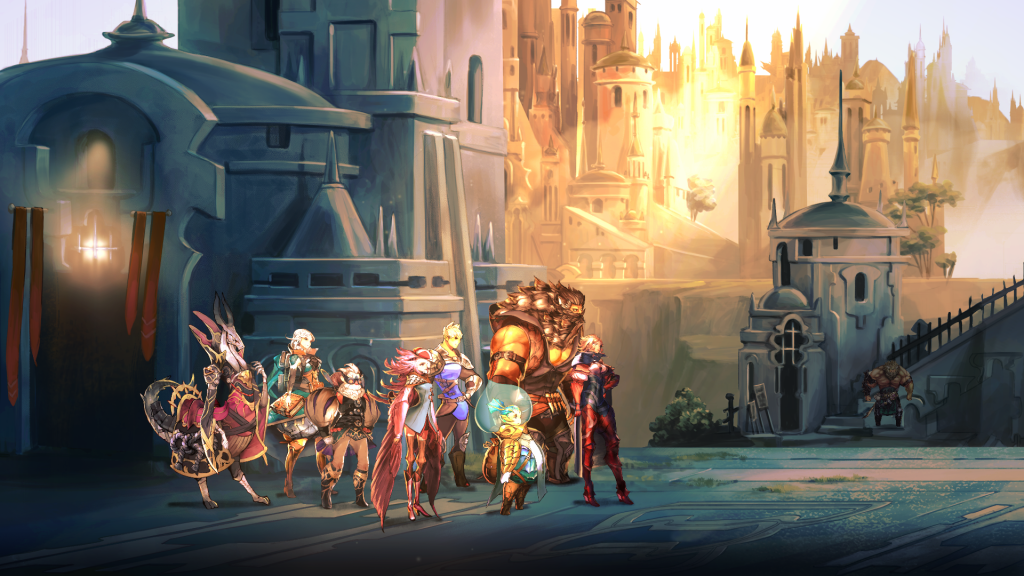
Astria Ascending is a JRPG by Artisan Studios, featuring a team of developers who worked on Final Fantasy, Nier Automata and Bravely Default. The game was also developed in partnership with Hitoshi Sakimoto, composer of Final Fantasy XII and Vagrant Story, and Kazushige Nojima, known for his writing for Final Fantasy X and Final Fantasy VII Remake. The story revolves around the world of Orcanon wherein you command a battalion of eight demi-gods who are tasked to protect Harmony from the Noises. You are granted powers once chosen as a demi-god, but are also subjected to a shortened lifespan of three years. After the three years have passed, another eight champions are appointed, beginning the cycle once again. The premise definitely held promise, but was a tad disappointing in its execution.
The game already stumbles at the very beginning, introducing you to the cast of characters at the tail end of their reign as demi-gods. You learn from the onset that they only have three months left to live. With this as your starting point, you don’t get the proper time to get invested in each character. There are moments in the game wherein you get a glimpse of each character’s backstories, but these moments are few and far in between, and never quite hit the mark. Even the relationships between the demi-gods felt a little strained, being more like a motley crew of so-called heroes forced to work with each other. Dialogue between characters fell flat, often resulting in them mocking each other like Arpajo and Eko. All in all, the game lacked exposition and I felt very detached and disinterested in the narrative partly because I couldn’t grow attached to these so-called heroes, and partly because of the haphazardly-done world building.

Where I will give the game much credit is in its art, there’s no question about it. Astria Ascending shines in its visually stunning 2D world. What drew me into the game from the trailer alone were the fully hand-drawn illustrations and beautiful landscapes, reminiscent of a Vanillaware game. There were moments while playing where I would simply pause and just admire the lush environments and the details of the artwork. In a way, I almost felt like a tourist within the game because of all the times I would catch myself merely sightseeing. It felt like being inside of a painting.
It’s a shame that its visual design is its most distinctive feature, because at the end of the day “pretty” can only get you so far. Just a few hours in and I already felt like the experience was a bit of a slog. While it is indeed similar in format to most JRPGs, the way the game progressed was borderline repetitive. A distress call would come from one of the districts, the cast of heroes would rush in to investigate, a backstory would ensue, the demi-gods would battle through Noises, and you’d wind up back at the Council Room in Harmonia. There wasn’t much you could do in between because quests had little payoff, the J-Ster mini game wasn’t really vital to your progress, and going on hunts was tiresome because of the lack of quest markers and badly designed map.

Combat, while not perfect, uses a turn-based format that would please most old school JRPG fans. It is what you’d expect from a game of this genre and is charming in its own regard, with a battle mechanic called “Focus” reminiscent of Bravely Default’s “Brave” and “Default” system. The difficulty seemed balanced enough and would trick you at times, making it feel like a cakewalk until a boss started to evolve into multiple forms. It challenged you to find the right weak spots, pick the optimal party, and be as resourceful as you could. The biggest flaw in its combat system however, is the lack of a turn indicator, making it difficult to plan your actions wisely. In addition to that, while immediately starting out with eight characters may seem like a good thing, it made me bench certain characters outright because it felt tedious to build the entire team.

Something else that Astria Ascending could have done without was the layer of complexity that came with the job system and ascension tree. The ascension tree in itself, similar to Final Fantasy X’s sphere grid, wasn’t a bad way to go about character progression. It was the fact that you needed stat orbs for certain parts of it, and the game showed you no clear way of attaining these stat orbs. From what I could tell, it seemed like it was a special drop from some enemy encounters. The job system also felt abruptly introduced, giving you a choice between three main jobs for each character with only a short one-liner to explain what the job entailed. You couldn’t even see the skill tree associated with the job. It felt like I was going in blind. You are only awarded two job orbs when the system is first introduced, and much like the stat orbs, there’s no way of telling when you’ll get your next orbs to unlock another job. Based on these instances, the game seemed to throw in many mechanics without much rationale, drawing inspiration from Final Fantasy and Bravely Default, yet making things unnecessarily complicated in the process.
Some quality of life improvements to Astria Ascending are definitely welcome. While they may not entirely fix what the game lacks, they would help make a more enjoyable experience. For one, being able to speed up battle animations or skip through dialogue during cutscenes would make the game feel a lot less sluggish. Adding quest markers or improving the map layout would also encourage players to explore the 2D world and make it easier to engage in more side quests along the way. Even making more sense of the weather system would be a nice touch, because as it stands, it seems like it was just added in as an afterthought.
Astria Ascending tries its best to be a jack-of-all-trades, yet fails in doing so. You can clearly see where the game drew inspiration from, but it would’ve benefitted from some editing down to focus on its better mechanics. While the game leaves much to be desired in certain aspects, it still does have its charm. In other words, it’s not bad, but it’s not great either. At the very least, the game is friendly for all types of players, with different settings to help you calibrate the difficulty at which you’d like to play. If you’re new to the genre or are a casual JRPG player, then Astria Ascending may be worth trying.
GameRev was provided with a digital download of the game for the purpose of this review.

